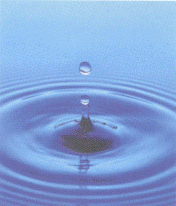A brief summary of some of the more common approaches
Bottled and Spring Water
The water quality is highly variable between one source and another. Bottled waters may become contaminated by synthetic oestrogen (xenoestrogens) in plastic bottles if stored for some time or if the bottle is left in sunlight.

Some bottlers treat their water with ozone, deionisation, carbon or micron filtration.
Some bottled waters are also high in sodium. People very seldom use bottled water to cook with.
However, some spring waters have healing properties and this might be associated with the unique structure of these waters. Maximum benefit is to be had by drinking these waters at source.
Carbon Filters
There are many different forms of carbon or charcoal filter. The simplest are the jug-type filters, using loose, activated charcoal (usually produced from coconut husks) but carbon filtration can be rather elaborate using loose, activated block filters and/or block filters.
The simplest types do a great job reducing chlorine concentration, gases, odours and taste, but do very little to protect against other contaminants.

Some reduce the concentration of some pesticides, other organic compounds and heavy metals

Some of the more comprehensive (read expensive) types such as large carbon block filters will also reduce the concentration of some pesticides, other organic compounds and heavy metals. Carbon filters, especially the small, loose carbon type, should be changed at regular intervals as they will build up potentially hazardous levels of bacteria and at saturation can start to unload toxins back in to the ’filtered’ water. Silver or ultra-violet bactericidal units are sometimes attached between plumbed-in carbon filters and the tap in order to control bacteria that can readily develop.
Again, many people with simple, jug-type carbon filters don’t use them for their cooking water or to fill up their kettle.
Ceramic Filters
These are made of clay, volcanic sand or magnetite stone. They are particularly good at removing heavy metals, other inorganic compounds (including nitrates and fluoride) and bacteria and cysts. The weakness of ceramic filters is the poor removal of organic compounds like pesticides, dioxins and oestrogens.
They have the benefit of being long-lasting and can be cleaned by the user. Water flow rates are normally slow so that people tend to use ceramic filters mainly just for drinking purposes.
Distilled Water
These are some of the most expensive systems for home installation and basically rely on the process of collecting the steam from boiling water.

Distillers make the purest water

Distillers make the purest water. Some argue that such pure water can actually leach minerals from the body but pure water cannot attract organically-bound minerals out of our bones or bodies in the manner claimed. Evidence for the fact that pure water does not leach minerals out of the body comes from the many tens of thousands of kidney patients using distilled water in dialysis machines who show no loss of mineral content in their bodies. One of the biggest drawbacks with distillation systems is their high purchase price.
Reverse Osmosis-based Filtration Systems
In many ways, state-of-the-art plumbed-in reverse osmosis systems give you the best of carbon technology combined with the benefits of reverse osmosis filtration. Reverse osmosis (RO) is a complicated process which uses a membrane under pressure to separate relatively pure water (or other solvent) from a less pure solution.

When two aqueous solutions of different concentrations are separated by a semi-permeable membrane, water passes through the membrane in the direction of the more concentrated solution as a result of osmotic pressure. If enough counter pressure is applied to the concentrated solution to overcome the osmotic pressure, the flow of water will be reversed. RO membranes typically have pore sizes of 0.0005 microns so water is generally produced slowly and stored in a tank. Once lime added to tap water has been removed, the water tends to be slightly acidic, but for the reasons given for distilled water this does not appear to be problematic in practice.
Some companies are able to attach ’mineralisers’ to their systems so that minerals can be added back to the water, so stabilising the pH. Commonly these are potassium and calcium. Obviously we should recognise that organic forms of minerals as found in foods are much more easily absorbed by the body than elemental forms. Combined carbon/RO systems produce water that is of a similar composition to rainwater. They are very efficient at removing or very substantially reducing the concentration of the full spectrum of organic and inorganic contaminants, pathogens and radioactive compounds.
The carbon filters tend to need annual replacement, while the RO membranes can generally be used for two to four years before replacement is required.
Alkaline water
The newest trend is to Alkaline water systems. This is ’in answer to’ the knowledge that an alkaline body is a healthy body. However, alkalinity is conferred on cells by the balance between having good levels of potassium and magnesium, and lowering sodium levels. It is not simply to do with the alkalinity of the water so be careful. Furthermore, a healthy body needs an acid gut. Flooding it with alkalinity might not be a good idea!
Go to: Why you need an acid gut but alkaline cells